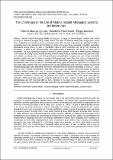| dc.description.abstract | Mobile Instant Messaging (MIM) encompasses a range of internet-based facilities that enable
exchange of real-time messages using mobile phones. The value of MIM has widely been recognized in recent
times, instigating an upsurge in its use across the society. The upsurge underscores the potential of MIM in
universities due to the strengths the technology presents such as real time messaging, versatility, portability,
affordability among others. In spite of manifested value of MIM, institutions are yet to fully embrace the
technology. In light of the aforementioned, this paper aimed to determine way forward in MIM use in
universities. The study specifically sought to assess the current situation in the use of MIM, identify challenges
in the context of existing success models and way forward. Mixed methods research design was used and survey
and multiple case designs were used. Both quantitative and qualitative strategies were used. Simple probability
sampling method was used to obtain a sample of 655 respondents drawn from four cadres of respondents in
Kenyan public universities as follows; ninety three (93) Information and Communication Technology (ICT)
administrative staff, ninety six (96) ICT technical staff, ninety eight (98) academic staff and three hundred and
sixty eight (368) students. Data was collected by the use of questionnaires and interviews. Validity was ensured
through triangulation, peer debriefing and review. Reliability test was done and generated a Cronbach’s Alpha
value of 0.827. Ethical considerations were taken into account and relevant clearances sought as required.
Thematic analysis method was used to analyze qualitative responses whereas descriptive and inferential
statistics were used to analyze quantitative responses. Findings revealed a high rate of use of mobile phones
and MIM in institutions, underscoring the potential and need for a suitable IS success model with MIM. In
particular, MIM penetration rate for academic staff stood at 63%, students at 60% and combined ICT
administrative and ICT technical staff at 34%. Findings of the study were considered important for the
academia given the MIM-related knowledge generated, and anticipated in the further research recommended
herein | en_US |

